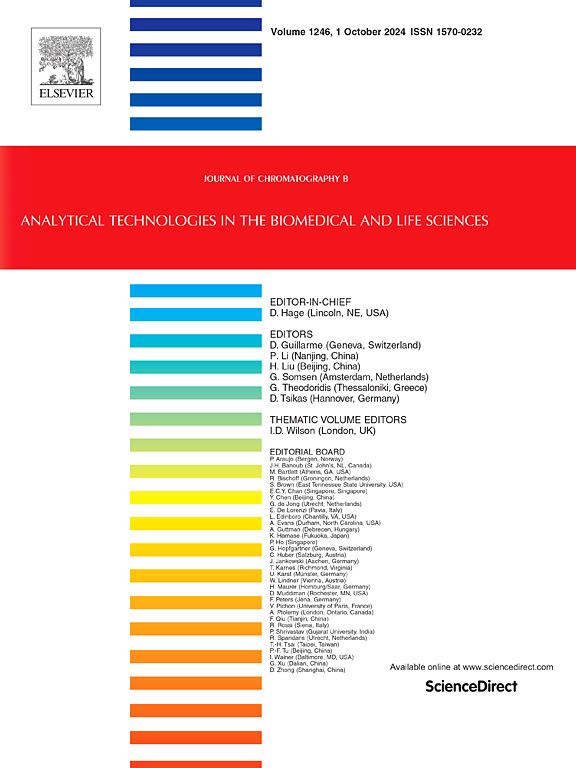Efficient host cell protein clearance: A study of membrane adsorbers and resins in biopharmaceutical processes
IF 2.8
3区 医学
Q2 BIOCHEMICAL RESEARCH METHODS
引用次数: 0
Abstract
In recent years, biopharmaceutical purification processes have shifted towards more productive and cost-effective methods. Membrane technology has emerged as viable alternative to conventional resins, capable of delivering similar product quality while facilitating a simpler and more flexible downstream purification process. This study compares the impurity removal efficiency of three anion-exchange media types (quaternary amine-functionalized agarose resin (Q Sepharose™ Fast Flow), cellulose membrane adsorber (Sartobind® Q), and a hybrid purifier, composed of two complementary anion-exchange media, a quaternary ammonium functional non-woven and a guanidinium functional polyamide membrane (3M™ Polisher ST)) in a flow-through mode during a monoclonal antibody product purification. The content of residual major impurities—host cell proteins (HCPs) and aggregates—were investigated using a design of experiments (DoE) approach, varying pH, ionic strength, and loading densities. Membrane-based devices exhibited high impurity removal capacity, with 3M™ Polisher ST capable of reducing HCP levels from 8000 ppm down to as low as 10 ppm at competitive loading densities in this case study. The presence of critical HCPs, such as esterases capable of hydrolysing ester bonds in polysorbates, was monitored using high-throughput enzyme assays and liquid chromatography-tandem mass spectrometry. Orthogonal HCP analytical methods were required for more informed process development, as esterase presence did not follow the same trend as the general HCP population. All chromatographic media were further tested for their robustness by conducting breakthrough experiments at an optimal pH of 6.5 and conductivity of 4 mS/cm. An additional orthogonal polishing step was required as anion-exchange chromatography alone was insufficient at clearing aggregates. Among options evaluated, 3M™ Polisher ST demonstrated the greatest potential for simplifying the purification process and enhancing productivity.
有效的宿主细胞蛋白清除:生物制药过程中膜吸附剂和树脂的研究。
近年来,生物制药纯化过程已转向更高效和成本效益的方法。膜技术已经成为传统树脂的可行替代品,能够提供类似的产品质量,同时促进更简单、更灵活的下游净化过程。本研究比较了三种阴离子交换介质类型(季胺功能化琼脂糖树脂(Q Sepharose™Fast Flow)、纤维素膜吸附剂(Sartobind®Q)和混合净化器(由两种互补阴离子交换介质、季铵功能无纺布和胍功能聚酰胺膜(3M™Polisher ST)组成)在流动模式下对单克隆抗体产物纯化的杂质去除效率。使用实验设计(DoE)方法,在不同的pH值、离子强度和负载密度下,研究了残留的主要杂质——宿主细胞蛋白(HCPs)和聚集物的含量。在本案例研究中,基于膜的设备表现出很高的杂质去除能力,在竞争负载密度下,3M™Polisher ST能够将HCP水平从8000ppm降低到10ppm。使用高通量酶分析和液相色谱-串联质谱法监测关键HCPs的存在,例如能够水解聚山梨酸酯中的酯键的酯酶。由于酯酶的存在与一般HCP人群的趋势不同,因此需要采用正交HCP分析方法以获得更多信息。在最佳pH为6.5,电导率为4 mS/cm的条件下,通过突破性实验进一步测试了所有色谱介质的稳健性。由于单独的阴离子交换色谱法不足以清除聚集体,因此需要一个额外的正交抛光步骤。在评估的选项中,3M™Polisher ST在简化净化过程和提高生产率方面表现出最大的潜力。
本文章由计算机程序翻译,如有差异,请以英文原文为准。
求助全文
约1分钟内获得全文
求助全文
来源期刊

Journal of Chromatography B
医学-分析化学
CiteScore
5.60
自引率
3.30%
发文量
306
审稿时长
44 days
期刊介绍:
The Journal of Chromatography B publishes papers on developments in separation science relevant to biology and biomedical research including both fundamental advances and applications. Analytical techniques which may be considered include the various facets of chromatography, electrophoresis and related methods, affinity and immunoaffinity-based methodologies, hyphenated and other multi-dimensional techniques, and microanalytical approaches. The journal also considers articles reporting developments in sample preparation, detection techniques including mass spectrometry, and data handling and analysis.
Developments related to preparative separations for the isolation and purification of components of biological systems may be published, including chromatographic and electrophoretic methods, affinity separations, field flow fractionation and other preparative approaches.
Applications to the analysis of biological systems and samples will be considered when the analytical science contains a significant element of novelty, e.g. a new approach to the separation of a compound, novel combination of analytical techniques, or significantly improved analytical performance.
 求助内容:
求助内容: 应助结果提醒方式:
应助结果提醒方式:


